
Have you ever been in front of an audience presenting a complex concept only to see in their faces that they’re not grasping what you’re saying? Not everyone has the same knowledge levels, much less about the same topics.
When you find yourself in this situation, it can be tough to bounce back and find another way to explain the complex concept to your audience. If not prepared, the panic might ruin your presentation.
So, how do you explain a complex topic to someone unfamiliar with it?
How can you communicate complex information so that anyone will understand?
Those are the questions we’ll be answering in this guide. We’ve collected our favorite techniques and tools from different corners of the web to give you a varied look at how anybody can explain anything to anyone.
Table of Contents
- What is a Complex Concept?
- Why are Complex Concepts Difficult to Communicate?
- 5 Proven Formulas For Communicating Complex Concepts so Anyone Can Understand
- 4 Examples of Effective Communication of Complex Concepts
- Case Study: Explaining The Cloud
- Mistakes to Avoid When Presenting Complex Ideas
- Conclusion
What is a Complex Concept?
First up, let’s get the big words out of the way.
Do you know the difference between complex and complicated? Knowing the distinction will help you learn to present, explain, and articulate concepts to audiences of varying backgrounds.
The main difference between complex and complicated is that complicated refers to the level of detail, while complex refers to the difficulty level. Both consist of many interconnected parts, but the difference lies in how the parts affect the outcome.
Complicated concepts have a cause and effect, an expected result. A complicated concept can be explained and shared using formulas and systems. Regardless if a person is familiar with a topic, they’ll have an easier time understanding a set of rules or steps to get through a complicated concept. Complex topics are less predictable and difficult to understand.
For example, the construction of a car is complicated. But the traffic flow of a city is complex. Cooking and serving a fancy dish in a restaurant might be complicated, but the effects on the diners in the room are complex.
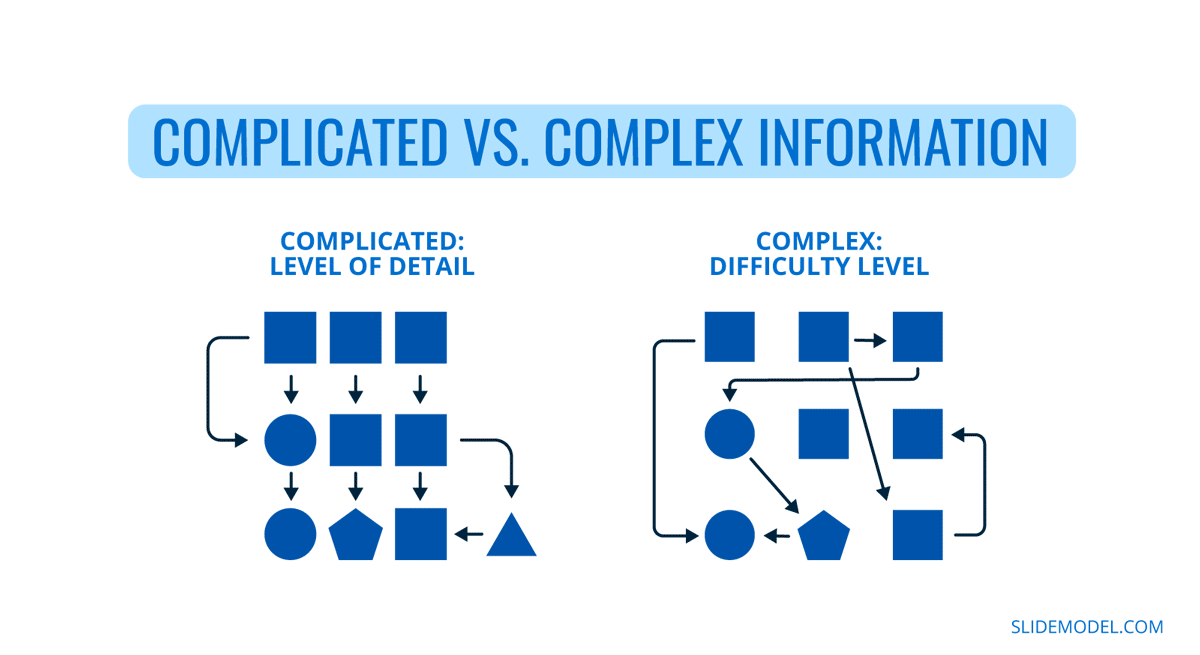
Why are Complex Concepts Difficult to Communicate?
Most complex concepts exist in mathematics and science, topics only a few people are fluent in. It might be easy and straightforward for a Ph.D. candidate with a thesis idea about a complex science concept to explain to peers. Still, it will be incomprehensible to people in other fields or academic backgrounds.
Unlike complicated concepts that can be explained with processes, many complex ideas are abstract or theoretical, making them difficult to convey with concrete examples or practical applications. For example, the concept of time is more challenging to explain than how to operate complicated machinery.
Complex concepts need to be studied and analyzed to get a full grasp of their scope. Experts on complex topics dedicate their lives to understanding and researching the material. Not everyone has that kind of time!
Likewise, the skill for communicating complex concepts doesn’t come quickly to everyone. It’s an ability that needs nurturing with practice and dedication. Even people who study complex concepts like quantum mechanics need to learn how to explain aspects of their work to unfamiliar people.
5 Proven Formulas For Communicating Complex Concepts so Anyone Can Understand
Now we’re getting to the good stuff.
Effectively explaining and presenting complex concepts is complicated yet not complex. Therefore you can use processes, structures, and systems to help you communicate any complex concept so anyone can understand. It’s a skill you can learn, practice, and master.
Not only scientists and researchers need to practice this skill, but also startup founders, executives, politicians, and community leaders. It’s such a critical skill that professionals worldwide have created systems and formulas for communicating complex concepts.
We’ve compiled a list of our favorite strategies that have helped us and can also help you improve your communication skills or complex concepts. As you go through the list, you’ll find similarities between strategies. Mainly, to communicate an unfamiliar concept, you need to:
- Meet the audience at their knowledge level
- Simplify
- Use analogies
Let’s dive in.
1. Mind Mapping
The concept of mind mapping is to visualize information that’s difficult to grasp and needs development with visual tools. First, you select the essential data about the concept; it can be the name or title. This preliminary information is the mind map’s center—or top—. From there, branch out secondary information that supports the first. Continue in this manner until you’ve developed the concept enough.
Mind mapping has many names; brain mapping, thinking maps, and thought organizing. But it comes down to simplifying a concept’s entirety by separating the pieces and examining connections and relations between them.
A mind map can help communicate your complex concept in two ways. First, it can help you strategize the text, presentation, and speech. A mind map or thought organizer can be the foundation for developing the communication of a complex topic.
Secondly, include a summarized mind map as a presentation slide. Not only is it a tool to develop explanations, but it’s also a visual tool to explain the concept to an audience. This final mindmap shouldn’t be precisely like the foundational mind map. It must be simplified and designed in a way that helps explain with engaging visual design.
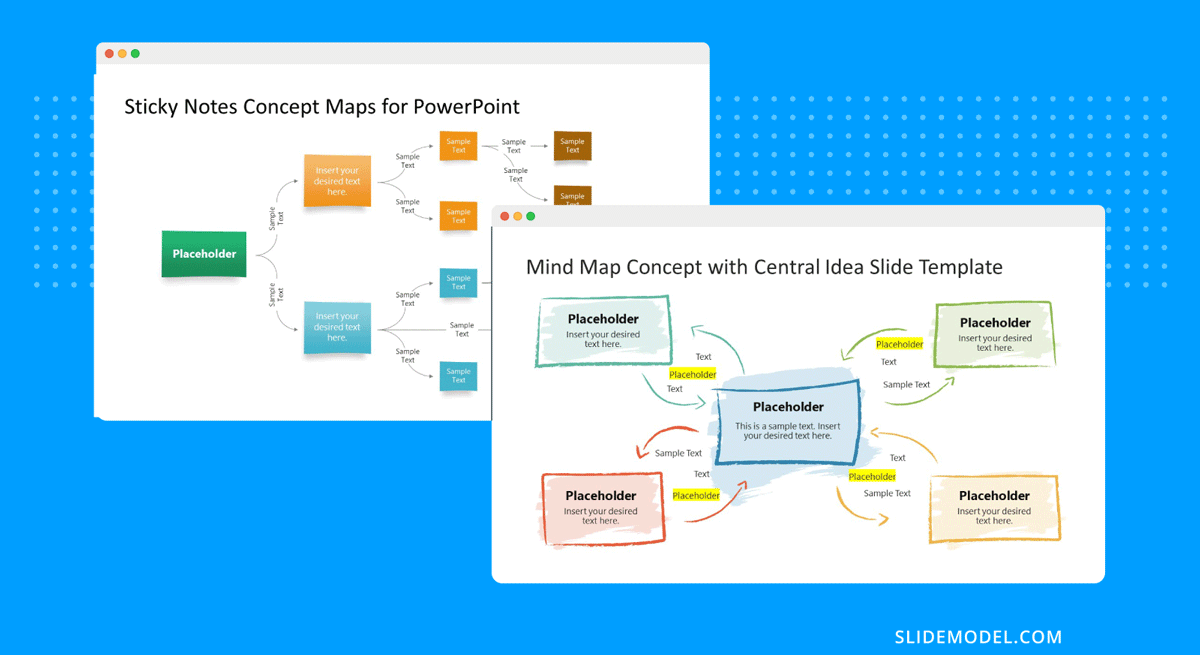
2. Storytelling and Analogies
Storytelling techniques are another proven method for sharing complex information. Using a story to explain a complex concept can be done in several ways. Stories can be used as an example or a way to share some background about the concept you’re discussing. The stories can be real-life examples or case studies that relate to your topic closely.
For stories to be compelling, they need to follow a literary structure. These are the four structures that best fit a presentation or a speech.
- The Hero’s Journey: Use the 12-step literary structure and apply it to science communication with a bit of creativity.
- Fact and Story: Share one fact and one story to support it. Then share another fact and a story to support it. Do this up to three times.
- What-How-Why: Explain the What, the How and Why in that order. Use a story as an example of each.
Nested Loops: Teel three different stories and then loop them in with similarities that refer to your topic.
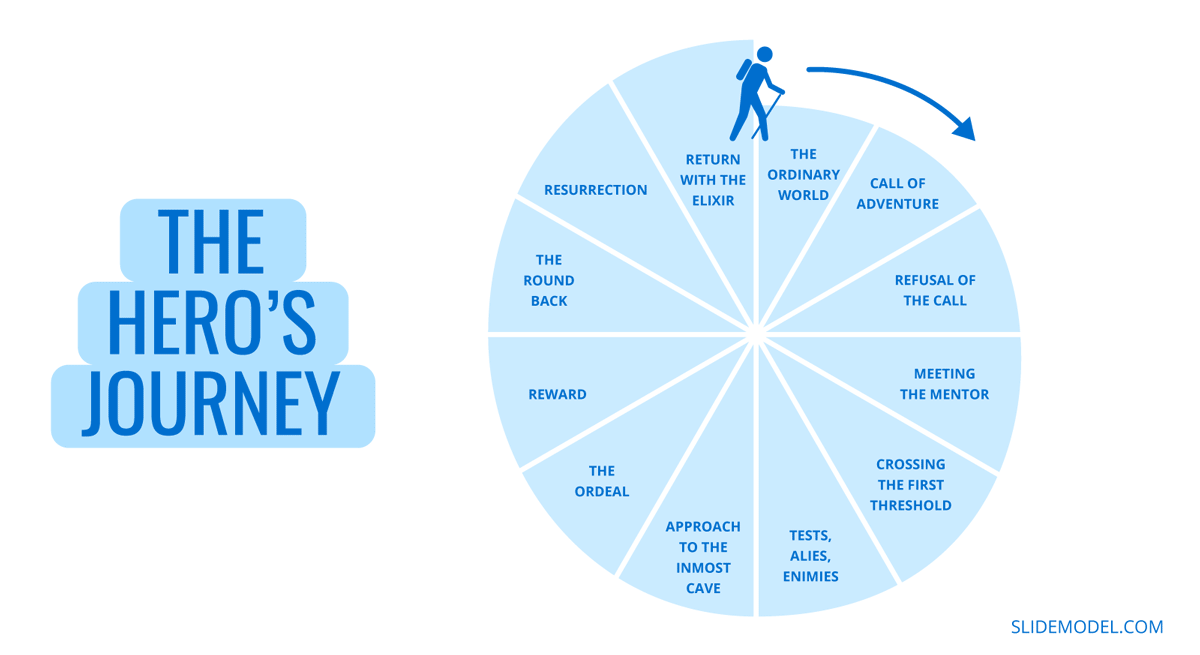
Another storytelling technique that’s particularly helpful for complex concepts is analogies. Analogies are so versatile that any concept—no matter how complex—can be explained using a story that’s completely different but similar in some way.
One of the most famous analogies of our time is the original iPod motto, “1,000 songs in your pocket.” Songs aren’t material things that can fit in a pocket like coins. But the digital data they take up, known by the developers and engineers as 5 GB, was too complex to explain to the general public in 2001.
3. Four-Step Formula from How Communication Works
In a video by How Communication Works, Bruce Lambert shares his four-step formula for effectively communicating a complex concept. They are:
- Simplify
- Focus on Problems
- Identify benefits or solutions
- Practice
The main idea of this formula is to concentrate on the benefits and solutions the complex concept offers about a specific problem. Consider the concept of time and how we measure it. Even though we know that the measurement of time is a human construct, it helps us live our lives in order and with stability. There’s no need to talk about how an hour has 60 minutes or a minute has 60 seconds.

Simplify and practice are extremely important to this formula. You need to simplify the concept according to your audience, and you also need to practice your presentation at different levels. This way, you will always be prepared to share your complex concept.
4. Visual Aids and Interactivity
Visual aids can be a big help in explaining complex concepts. Although if your storytelling skills are well-developed, you don’t need visual aids at all. Or maybe just a couple.
Infographics and videos are the most common visual for explaining complex concepts. These visual types take a cue from storytelling and perform best when created with visual metaphors. Dry data and information on a canvas are no better than a boring speech.

Interactivity makes your complex topic more accessible to anyone interested in learning about it. Interactive techniques include quizzes, hands-on activities, roleplaying, and conversation. Interactive science museums are one of the most engaging educational formulas.
After simplifying and visually representing complex data, the next step is to compile your insights into presentation-ready reports. These reports serve as the bridge between your deep understanding of a complex subject and the clear, accessible format needed for diverse audiences.
5. Matt Abrahams’s 6 Tools
In the Stanford Business blog, Matt Abrahams shares six tools to help explain complex concepts. Using the example of “Shooting a Bow and Arrow,” his team created this infographic to demonstrate each technique.
Take a look at Matt Abrahams’ tools:
- Diagram: Display the concept visually. We talk about this in the mind-mapping technique above.
- Deconstruct: Simplify. Dissect and take apart the concept into smaller parts.
- Compare: Use analogies to explain the complex concept using simple words and stories.
- Picture: Create and use visual aids to help develop and explain the concept.
- Backward Map: Start from the end and work your way back to the beginning.
- Chunk: Separate and categorize the concept into parts of similar subparts.
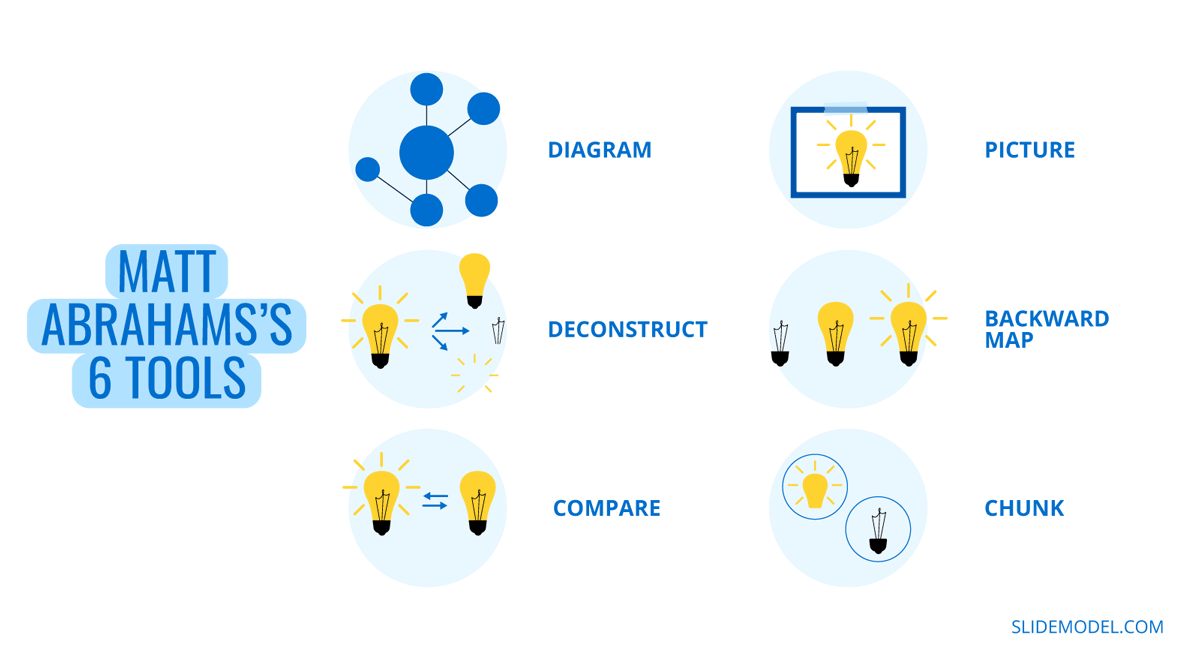
Pro Tip: Enhance your explanation strategy by using a comparison slide template. These slide templates can be effective for juxtaposing different concepts, illustrating contrasts or similarities with clarity. Whether you’re comparing two parts of a concept, different approaches, or contrasting theories, one of our slide comparison template can visually organize the information, making it more digestible for your audience.
4 Examples of Effective Communication of Complex Concepts
Like learning any skill, communicating complex concepts must be learned. One of the best ways to acquire and increase your knowledge is to look at real-life examples. Inspiration is a conduit to action; it makes you feel like what you seek is an attainable skill.
For Dummies – Book and Content Series
When DOS for Dummies launched in 1991, the publishing market was full of beginners’ computer books that no one wanted to read. The author of DOS for Dummies, Dan Gookin, had the idea to create a beginner’s book that was fun and entertaining for people that wanted to learn to use computers but were overwhelmed. After all, in the early ’90s, computers were a novel complex concept!
The “For Dummies” book and digital series uses humor to make learning lighthearted and easy.
There’s a formula.
The central concept is separated into snackable sections of related topics. Each section has several chapters that relate to that topic. All the content is searchable with an index, meaning that people can choose to read from beginning to end or look up what they want to know on the spot.
Interactive Science Museums for Children
Another excellent example of how to communicate complex concepts to an audience with little or no knowledge of the subject is interactive science museums. The primary audience of these museums is school-age children, but their parents can also learn something new if they come along.
Are you looking for inspiration to explain complex information to anyone? Visit an interactive science museum and pay attention to their techniques. Try the activities and analyze your grasp of what the experience is teaching. How can you incorporate these ideas into your communication of complex concepts?
5 Levels Video Series
In Wired’s YouTube Channel, look for the 5 Levels Video Series. In these videos, experts from various fields explain a topic in five increasing levels of complexity. The five levels are; child, teen, college student, grad student, and expert.
Some of the complex concepts they have tackled in this series are astrophysics, music theory, quantum computing, and blockchain. Watch these videos to learn how to tailor how you explain the concept according to your audience’s communication level.
Infinity Ted Talk
Few things are more difficult to explain than the complex concept of infinity in mathematics. This whiteboard-style TED Talk explains the infinity of infinities with vibrant visual illustrations. Even if you’re not much into mathematics, you’ll be able to understand at least 80% of it.
Case Study: Explaining The Cloud
Matt Abraham’s analysis and infographic on explaining complex concepts using 6 tools inspired this article. We appreciate how he shares actionable formulas to explain concepts, all wrapped up in one main formula you might not have noticed.
Create an overarching categorization of terms that make up your concept. Everything else grows from that. We recommend using this top-level formula as a foundation when preparing and presenting information about a complex concept.
Let’s consider the challenge of presenting what The Cloud is. To explain The Cloud efficiently and without confusing anyone, we can separate it into four main categories.
- What is The Cloud?
- Cloud Types
- Cloud Services
- Cloud Benefits & Risks
This categorization formula is the same formula writers, and content managers use for outlining articles and guides. It’s the same for web designers and e-commerce sites; categories are essential for creating a thread of understanding in any concept; simple, complex, or complicated. You’ll be surprised at how much easier everything becomes when using a formula as a guide.
As an example and in the spirit of Matt Abraham’s infographic, we’ll explain how to apply a formula to each category in The Cloud.
Mind-mapping
Using the “Diagraming” concept, and the mind-mapping technique explained earlier, we can try to explain what The Cloud is.
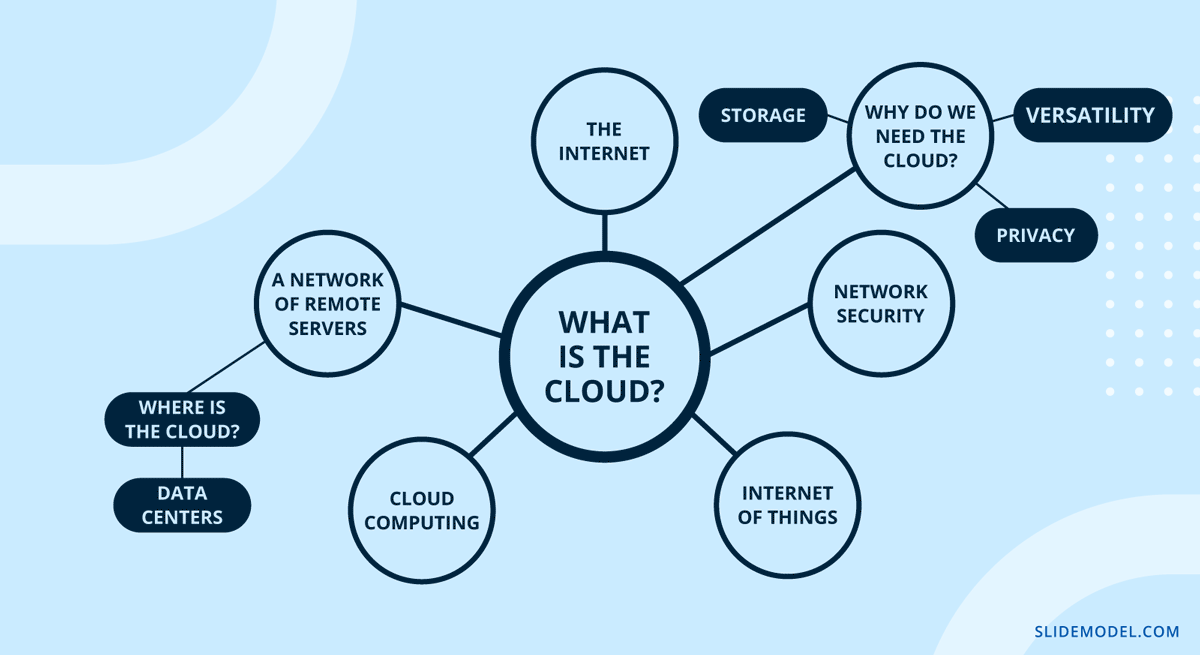
We start with the initial question: “What is The Cloud?”. Then, the second iteration of associated concepts answers the question by presenting a network of servers, introducing the internet, raising a question on its utility, and linking cloud computing, the Internet of Things (IoT), and network security.
By deepening into what remote servers are, we can ask ourselves, “Where is the Cloud?”, which the answer goes one indentation deeper by answering Data Centers. The same order logic is applied to reply: “Why do we need The Cloud?”. Then, we reply by highlighting Storage, Privacy, and Versatility as the main perks of working with The Cloud.
The mind mapping technique quickly helps us to identify concepts linked to the main idea we want to explain, boosting a creative thinking process.
Analogies
Using the “Picture” and “Compare” Techniques, you can present analogies to known concepts, that can explain the difference between Public, Private, and Hybrid Clouds.

The image above explains the access options in Private vs. Public Cloud, referred to at an organizational level. To explain it in simpler words, a Public Cloud can be accessed from the Internet. The immediate model we can think of is a subscription service available for all customers with the same interests. On the other hand, the Private Cloud is restricted by an organization’s Intranet, and not shared publically.

In the image above, it is clearly understood how the center of the definition is based on the “organization” and the owner of the resources. In the Public Cloud, the organization “hires” the services from a third-party provider (SaaS, PaaS, IaaS). In the Private Cloud, the organization hosts its own services, and in the hybrid scenario, the organization combines on-premise and off-premise resources to use services.
Four Step Formula
To use the “Chunk” method, we can apply the Four Step Formula for the next category, Cloud Services. Imagine you need to prepare and present a slide presentation and speech about services in The Cloud. The Four Step formula for explaining complex concepts is your ideal partner.
Let’s follow the formula.
- Simplify: Define Cloud services in as few words and sentences as possible.
- Focus on Problems (Pain points): Prepare talking points about topics like security concerns, compliance, data migration.
- Identify benefits or solutions: Explain how cloud services fix those problems and how.
- Practice: Prepare the slides and presentation speech. Practice the talk many times, using different audience types as inspiration. Try a variety of talking styles until you feel confident.
Visuals
Explaining Benefits vs. Risks is a process easily understood when using a visual model such as a Comparison Chart. In this case, we shall present the list of Cloud Benefits & Risks by constructing that comparison in a visual format, helping users quickly spot whether a feature can be considered a benefit or a risk.

Mistakes to Avoid When Presenting Complex Ideas
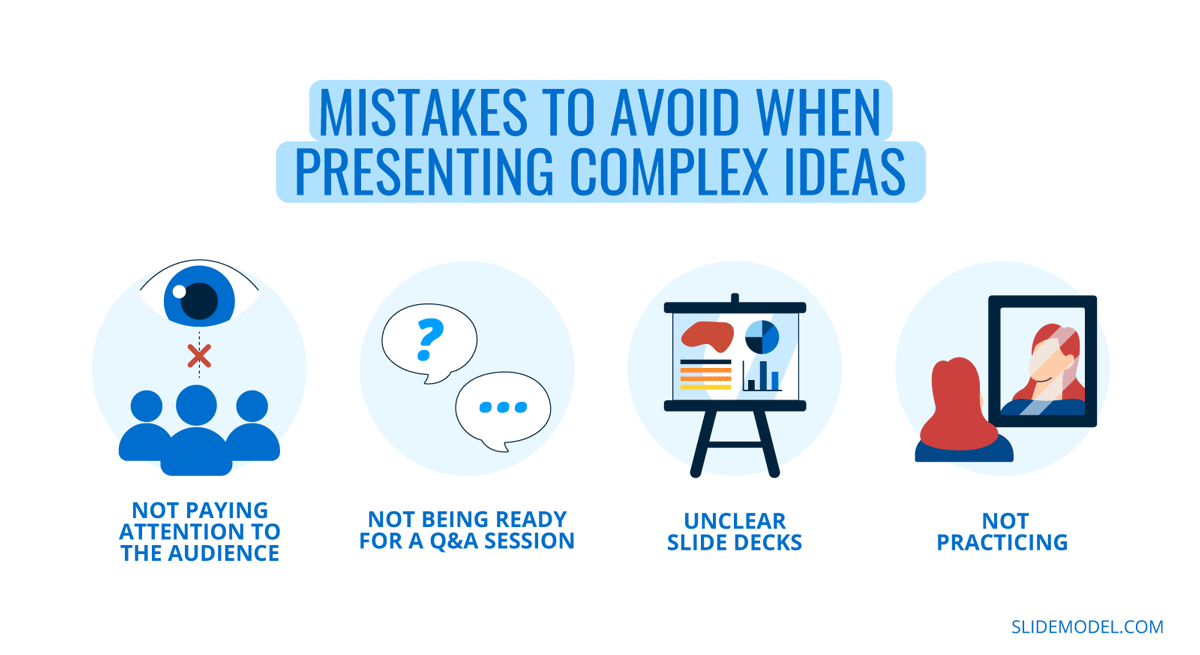
Learning many ways to communicate complex concepts efficiently is excellent. But better than that is knowing what NOT to do. Here are the biggest mistakes to avoid when communicating topics you want the audience to understand.
Not Paying Attention to The Audience
When presenting a complex concept, the first mistake is not paying attention to your audience. Being disconnected from the audience doesn’t help your cause; you need to make a connection from the start.
For that, you need to know the audience’s knowledge level of your topic. This information will help you decide the difficulty level you’ll use while presenting and how much industry jargon they’ll understand.
Find out as much as you can about the audience before presenting. Preferably before making the presentation. Ask these questions:
- What is the average age of the audience?
- What’s their average level of study?
- If adults, what average level of academic studies do they have, and in what fields?
The second instance where you can’t afford not to pay attention to the audience is when you’re presenting to them. Connecting with the audience will help them understand your complex topic and make you feel better as you talk, consequently improving the learning experience for everyone.
Mastering the art of connection with the audience using body language, compelling conversation rhythms, and making an impact aren’t innate skills for everyone. Most of you will have to learn, practice, get feedback, and practice some more.

Not Being Ready for a Q&A Session
Questions are a tricky topic concerning presentations like keynote speeches and TED Talks. Some keynote speeches will have a Q&A Session, while no TED Talk will ever have one. Allowing questions in the middle of a presentation is detrimental to the session. They can take you off on tangents that will be difficult to come back from.
On the other hand, Q&A sessions at the end of a presentation can dilute the message or the impact the speaker has on the audience. TED Talks don’t have Q&A Sessions for this reason, to not take away from the presenter’s idea worth spreading.
Nevertheless, many presentations of complex concepts are educational and need a Q&A session to be comprehensive and of value to the audience. As a presenter, you need to be ready to answer some questions. You obviously won’t always know what the audience will ask, but you can deduce some questions by practicing with colleagues and peers and asking for feedback.
Unclear Slide Decks
This mistake refers to your visual presentation slides. Regardless if you’ll distribute the slide deck on its own or only use it as support when presenting, your slides can’t be communication disasters. Use PowerPoint templates to help with a graphic design foundation and adjust them with your information.
Be mindful of data visualization, mind maps, and visual metaphors. Ensure that your visualizations correctly represent your information and that nothing gets lost in translation. Remember to be clear and concise with infographics and widgets.
Get rid of clutter, use consistent colors, don’t mix too many fonts, and keep elements aligned. Browse the SlideModel Blog and improve your presentation skills with our design guides.

Not Practicing
Finally, a huge mistake to avoid is not practicing. Complex concepts are naturally difficult to understand; it’s up to you, the experts, to make them accessible. It’s not only about practicing a speech about a complex concept; it’s also about developing a strategy for sharing complex information.
If you want to be a master at communicating complex concepts to anyone, write your speech or main presentation points in different tones and for different audience levels. Practice them all and feel confident at every level. You’ll be so prepared that the audience will be smiling and nodding as you look at them and connect.
Do some research on other speakers and take some notes. For example, in the 5 Levels Video Series from Wired, you can watch and listen for similarities and differences at each level. Does the speaker change their body language? Are there props involved? Notice how the vocabulary and technical jargon increase as the levels go up.
And, of course, practice your articulation and speech cadence to be compelling and exciting to listen to.
Conclusion
Are you feeling the pressure? Communicating complex concepts isn’t easy. If it were, everyone would do it, and guides like this wouldn’t exist.
Thankfully, since the concept of explaining complex concepts is complicated and not complex, you can follow formulas, systems, and processes. Practice using mindmaps and visualizations as you develop the concept before preparing a presentation. Before you start to consider how to start a presentation, give yourself the space and time to try different techniques and practice explaining your concept at different levels.
Use SlideModel templates to build your presentation slides on PowerPoint and practice presenting with them. Become one with your slides, let the speech flow naturally, and let the words articulate well from your mouth. You’ll be surprised at how well audiences understand your complex concept next time you’re up on a stage or as the speaker in a virtual meeting or summit.


